How to Add Layers in Corel Draw X6
So Simple It's Dangerous
CorelDRAW Series Part 6: by Steve Chittenden
Notice:
This article is most ideal if you are using CorelDRAW 11, 12, X3, or higher. Those using older versions like CorelDRAW 9 or 10 will find my archived version of this article much better.
I think it is safe to say CorelDRAW is a victim of its own simplicity. Even someone with minimal skill can produce graphics, which is both good and bad. Corel is so easy to use that professional graphic designers sometimes hate it just because it enables people with no artistic ability to create visual pollution.
What sometimes seems to get missed is that Corel also has the ability to streamline the work of a professional graphic artist. Compared with other tools, I find it is usually easier and faster and more powerful than other programs. Features that Corel had several years ago are either just being introduced by the leading design programs, or are still not available.
In this part of the series, we will look at some higher level design techniques. Some are common to other programs, others are either unique to Corel, or ones that Corel is better at. Node Editing is one of the areas where Corel is far simpler than other programs (if you don't have a clue about Node Editing, you will after reading this).
More Power and More Control
If you have worked in graphic design very long, you may already be familiar with the power of layers. Because design programs like CorelDRAW create a "stacking order" based on each object created, you might not be taking advantage of the extra control available to you. Stacking order just means when you create an object, then create a second object, the second object created will "stack" on top of the first object, the third object will stack on top of the second, and so on. Stacking order and layers are technically different.
If you have not yet discovered the greater control of using layers, get ready to open a whole new realm of possibilities. If you have wished you could make one object invisible so you could work on another object, then reappear when you need it back, this will excite you. If you have ever wondered if there is a way to select just the objects you want, and lock the rest, there is. If you have ever had trouble selecting a line or object that is on top of a guideline, get ready to discover an easy solution to that problem.
From the Menu bar, click on Window, then Dockers, then Object Manager. Now you have a powerful tool (see below) ready right when you need it. I already introduced you to Dockers in Part 4 of this series, and you can see in the image below that the Contour Docker is still there too, but we are stepping up to a higher level now.
The idea of working in layers is common to all good graphic design programs. I do find Corel to be the easiest, especially if you are working with multi-page documents. Kids, don't try multi-page documents using Adobe Illustrator or Photoshop; you need to spend the extra bucks for InDesign to get that ability.
NOTE: Beginning with Adobe CS4, Illustrator does now support multi-page documents (called artboards).
 Aside from easy management across layers and between pages, here are some other features to be aware of with the CorelDRAW Object Manager.
Aside from easy management across layers and between pages, here are some other features to be aware of with the CorelDRAW Object Manager.
- The icons are easy enough, the eye icon turns visibility of the layer on and off
- The printer icon determines whether it prints or not
- The pencil icon toggles whether you can edit or not; it is equivalent to locking the layer
- If you are having trouble selecting objects because of a guide line, click on either the pencil or eye icon next to Guides under Master Page
- Remember too that any object selected will provide a readout on the Status bar telling you what layer that object is on
- You can rename, or add, both pages and layers using the Object Manager
- You can Cut or Copy the objects from any layer on any page, and Paste them to any other layer or page by simply selecting the destination layer on the Object Manager before Pasting
- The middle icon at the top is called Edit Across Layers
- If you toggle the Edit Across Layers off, only objects on the active layer can be edited
- If Edit Across Layers is on, you can select and edit any object on any layer as long as it is not locked or invisible; you get to choose which way you want it
- Using the layer icons will control what is visible or not, and what can, or can't, be edited
Are you loving this?
One behavior I find annoying (a known default setting in versions 11 and higher) is when you select an object on the page and the Object Manager automatically opens up the layer properties (expands). To change that, there is a single arrow button near the upper right corner of the Object Manager. Make sure there is NOT a check mark next to the Expand to Show Selection option.
Imagine the power you just discovered if you did not already know about this feature. You can scan in a sketch or rough draft and put it on its own layer, then draw on top of it toggling the visibility of the sketch layer on and off to get a better view of your work as you go. Oh yeah, we will be doing that and delving deeper in the next article. After all, this is a drawing program.
You can create multiple versions of the same object or idea and turn the visibility of layers on and off. You can jump to a certain page very easily in the Object Manager. This works better than using the page list at the bottom of the workspace, especially if you have a lot of pages (you can collapse page properties to display even more pages in the Object Manager). Be sure to explore all the functionality of the Object Manager, it will change the way you use the program.
Roll Up Your Sleeves and Get Ready To Edit Nodes
Once we do this, you are going to begin to see the value of creating your own drawing objects because sometimes cleaning up someone's mess can take longer than just creating a new object.
An important thing too is that less is often better. A node is a control point on a line. If there are too many of them, the line may look bumpy when enlarged. Less of them will create a nice smooth flowing line.
Let's start with a simple line. Don't worry, I have some really cool things to show you, we're just going to work in logical order here.
-
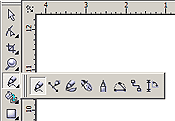 Press and hold for a second on the drawing tools on your toolbar to reveal the flyout of all the drawing tools (see example on right). You can now drag this flyout by the double line handle to any location if desired. We will be using the Freehand Tool which is shown selected here.
Press and hold for a second on the drawing tools on your toolbar to reveal the flyout of all the drawing tools (see example on right). You can now drag this flyout by the double line handle to any location if desired. We will be using the Freehand Tool which is shown selected here. -
With the
 Freehand Tool selected, click and drag on the page to draw a line. Don't worry if it doesn't look smooth. That will take practice, but part of the point here is that this may not be the best method in many cases, so I'll cover other methods too. Notice the settings on your Property Bar shown below with the Freehand Tool selected: one of them is for Freehand Smoothing. I created the blue top line shown with 100% smoothing, which should be your default setting, and the bottom red line was set to 0% smoothing. Experiment with these settings. There are less nodes (control points) and much smoother lines when Freehand Smoothing is set higher (like the blue line). Also notice you can use different line types, along with other settings.
Freehand Tool selected, click and drag on the page to draw a line. Don't worry if it doesn't look smooth. That will take practice, but part of the point here is that this may not be the best method in many cases, so I'll cover other methods too. Notice the settings on your Property Bar shown below with the Freehand Tool selected: one of them is for Freehand Smoothing. I created the blue top line shown with 100% smoothing, which should be your default setting, and the bottom red line was set to 0% smoothing. Experiment with these settings. There are less nodes (control points) and much smoother lines when Freehand Smoothing is set higher (like the blue line). Also notice you can use different line types, along with other settings. -
Select the
 Shape Tool from the toolbar and click on a line you have drawn with your Freehand Tool. Your Property Bar will look similar to the one shown below. The options and the ease of use are what make CorelDRAW such a pleasure to use in my opinion. To me, Adobe is maddening in its clumsy, more complicated approach to the Node Editing you can now do. Here are some nice shortcuts to be aware of:
Shape Tool from the toolbar and click on a line you have drawn with your Freehand Tool. Your Property Bar will look similar to the one shown below. The options and the ease of use are what make CorelDRAW such a pleasure to use in my opinion. To me, Adobe is maddening in its clumsy, more complicated approach to the Node Editing you can now do. Here are some nice shortcuts to be aware of:
-
Get familiar with the icons on the Property Bar when working with the Shape Tool. There is one for Select All Nodes. Once all nodes are selected, there is an Auto Reduce Curve icon which removes excessive nodes (it can be clicked more than once to keep reducing nodes). This tool is not magical, so use it carefully or it can alter the shape of your object more than desired (remember Ctrl+Z if this happens). It can also be very useful in reducing excessive nodes and smoothing curves. For those using CorelDRAW X3, there is also Reduce Nodes command which you may want to experiment with to see which works better in different situations.
-
If some of the tools you need are not on the Property Bar, you can add them using the techniques from Part 1 of this series. Make sure you select a curve first to activate the correct Property Bar.
-
With the Shape Tool, point to any spot on a curve and double-click. This will add a node. If you double-click on an existing node, it will delete that node.
-
Take note of the three node type options: Cusp, Smooth, and Symmetrical. Notice the effect each type has when you drag the "handles" that appear after you select a node.
-
If you know that most of the nodes are going to be a certain type, like Cusp for example, then do a Select All Nodes and choose Cusp, or whichever one you want the node type to be. You can also use the Shift key and click to select nodes one at a time, or do a Select All and deselect the ones you don't want using the Shift key while clicking (if you want all but a few selected).
-
Note that you can also adjust the Curve Smoothness from the Property bar.
-
-
Next, behold the power of the
 Bezier Tool. You can click anywhere, and each time you click, it will create a point. If you want to stop, simply press the Spacebar after creating the last point. If you want to start another curve, press the Spacebar again and begin a new drawing that will not connect to what you just drew. If you want to continue a curve, click on an end node first (you will see a bent arrow appear on your cursor) and you can keep adding nodes to an existing curve.
Bezier Tool. You can click anywhere, and each time you click, it will create a point. If you want to stop, simply press the Spacebar after creating the last point. If you want to start another curve, press the Spacebar again and begin a new drawing that will not connect to what you just drew. If you want to continue a curve, click on an end node first (you will see a bent arrow appear on your cursor) and you can keep adding nodes to an existing curve. -
You can Combine objects you have drawn too. If you combine two or more curves and you want to connect the nodes (suppose there is a break in a line that you want connected), simply drag one node on top of another and Corel will automatically join them. NOTE: This only works with end points or nodes where you have created a break (there is a Break Curve icon on the Property Bar).
-
If you are creating a closed curve, which is common, when you get around to where you started at, the cursor will change to a bent arrow while you are over the starting node. Click while the bent arrow is displayed to close the curve. There is also an Auto Close Curve option on the Property Bar. Note that a curve cannot be filled unless it is closed.
-
With the Bezier Tool selected, click somewhere on the page, but this time, drag slightly while holding down the mouse button, then release. Go to another point, click and drag, then release. Try dragging different directions and distances. This will feel awkward and clumsy at first, but don't worry about that. With practice, you will get much better and it provides a great way to quickly draw an object. Also remember that you can fine tune an object after it is drawn using node editing, so it is not important to have it perfect using this technique.
-
There are some nice additional drawing options in the Drawing Tools flyout not covered here (I only covered 2 of them), so you may want to explore and experiment with those too.
![]()

Now Some Real Fun Begins
We're moving on to some lesser known, but power features of Corel.
-
Select the
 Ellipse Tool and let's start with real simple ellipse. Use the Control (Ctrl) key to constrain while dragging to make a perfect circle. Don't worry about the size. By default, your ellipse should have a hairline black outline and no fill color; this is fine for now.
Ellipse Tool and let's start with real simple ellipse. Use the Control (Ctrl) key to constrain while dragging to make a perfect circle. Don't worry about the size. By default, your ellipse should have a hairline black outline and no fill color; this is fine for now. -
There might be a
 Convert to Curves icon on the Property Bar, otherwise, with the circle selected, choose Arrange from the Menu bar, then Convert To Curves.
Convert to Curves icon on the Property Bar, otherwise, with the circle selected, choose Arrange from the Menu bar, then Convert To Curves. -
Notice how there are four nodes. With the
 Shape Tool, select just one of the nodes. You will see handles appear, but do not use them. Next, click the + sign on the Property Bar (or on your numeric keypad). Notice how it adds a node centered between the selected node and the next one in the counter clockwise position. Click the + sign again to see what happens.
Shape Tool, select just one of the nodes. You will see handles appear, but do not use them. Next, click the + sign on the Property Bar (or on your numeric keypad). Notice how it adds a node centered between the selected node and the next one in the counter clockwise position. Click the + sign again to see what happens. -
Now use the Ctrl+Z keys twice to Undo those extra nodes.
-
Select all four nodes on the circle. Click the + sign on the Property Bar twice. See how it doubles the nodes evenly spaced on the circle each time. You should now have 16 nodes.
-
 With the circle still selected, look for the Interactive Distortion Tool on the Interactive Tool Flyout shown here. The Interactive Tools in CorelDRAW are unequaled by any other graphics program in my opinion.
With the circle still selected, look for the Interactive Distortion Tool on the Interactive Tool Flyout shown here. The Interactive Tools in CorelDRAW are unequaled by any other graphics program in my opinion. -
Use the Distortion Tool to create all kinds of effects. I have shown just a few simple ones below.
-
Be sure to play with this tool because it can yield an unlimited number of effects. Try all kinds of options on the Property Bar and see what happens. Try the Add New button and create even more different distortions.
-
 Experiment with colors too. Try different kinds of fills and colors too. Also on the Interactive Tool Flyout is the Interactive Blend Tool. Create two objects and try different blending effects like the one on the right. To do this, I distorted the circle like the center image above, removed the outline and filled it with yellow. I then duplicated the distorted object (Ctrl+D), and using the Shift key, I reduced the size to the center of the flower and filled it with orange. After applying a Blend, voila. Make sure to try different settings with the Interactive Blend Tool for different effects.
Experiment with colors too. Try different kinds of fills and colors too. Also on the Interactive Tool Flyout is the Interactive Blend Tool. Create two objects and try different blending effects like the one on the right. To do this, I distorted the circle like the center image above, removed the outline and filled it with yellow. I then duplicated the distorted object (Ctrl+D), and using the Shift key, I reduced the size to the center of the flower and filled it with orange. After applying a Blend, voila. Make sure to try different settings with the Interactive Blend Tool for different effects. -
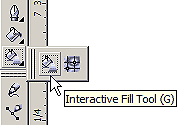 While you are playing with the Interactive Tools, be sure to check out the Interactive Fill Tool. Note that the Interactive Fill Tool is in a different flyout as shown to the right. Once you have experienced these tools, other graphics programs will leave you far less impressed. Be careful with file sharing in vector formats other than PDF when using these tools though. Even the expensive programs can't always replicate the effects; you are working with some real power here.
While you are playing with the Interactive Tools, be sure to check out the Interactive Fill Tool. Note that the Interactive Fill Tool is in a different flyout as shown to the right. Once you have experienced these tools, other graphics programs will leave you far less impressed. Be careful with file sharing in vector formats other than PDF when using these tools though. Even the expensive programs can't always replicate the effects; you are working with some real power here. -
With these distortions, it's important to know you are still preserving your original object. Each time you click the Clear Distortion icon on the Property Bar, your object reverts to a previous state, and you can go all the way back to the original object even with multiple distortions applied. This also works after saving, closing, and reopening the file as long as you don't convert the distortion to curves.
-
If you are sharing a file using these types of effects, I highly recommend using the Publish to PDF option in the File menu, since this is the most reliable way to share files. Be aware that Adobe Illustrator will open a PDF directly, and sometimes it looks different in Illustrator than it will in Adobe Reader! Be sure to use hard copy and request that your recipient view it in Reader, and not just in Illustrator.
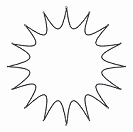
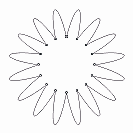
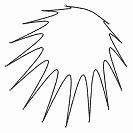
All three of these use the Push/Pull option (note all the options on the Property Bar). On the first two above, I started from the center and pulled outward. The direction you pull matters because on the first one (far left above), I pulled to the right, on the center image, I pulled to the left. For the far right above, I started on an outside node at 45 degrees and pulled downward.
Putting It All Together
This series would not be complete without a practical example that puts together all these techniques and principles we've covered so far. The next article will provide a practice project that will introduce you to some powerful tools you may not have used before, plus, it will take advantage of what we covered here. It's complete with a finished file you can download to get a closer look.
Next.. Ready, Set, DRAW!!!
© 2016 Steve Chittenden
Steve Chittenden owns and operates Creative Business Services which provides web design, graphic design, writing, and marketing services. If you have a web site that could benefit from this CorelDRAW material, please feel free to link to these pages.
How to Add Layers in Corel Draw X6
Source: https://www.cbscreative.com/corel06-dangerous.htm
0 Response to "How to Add Layers in Corel Draw X6"
Enregistrer un commentaire